WHY TRUST REVIEWED?
Best Indoor Securıty Cameras 2023, Reviewed’s mission is to help you buy the best stuff and get the most out of what you already own. Our team of product experts thoroughly vet every product we recommend to help you cut through the clutter and find what you need.
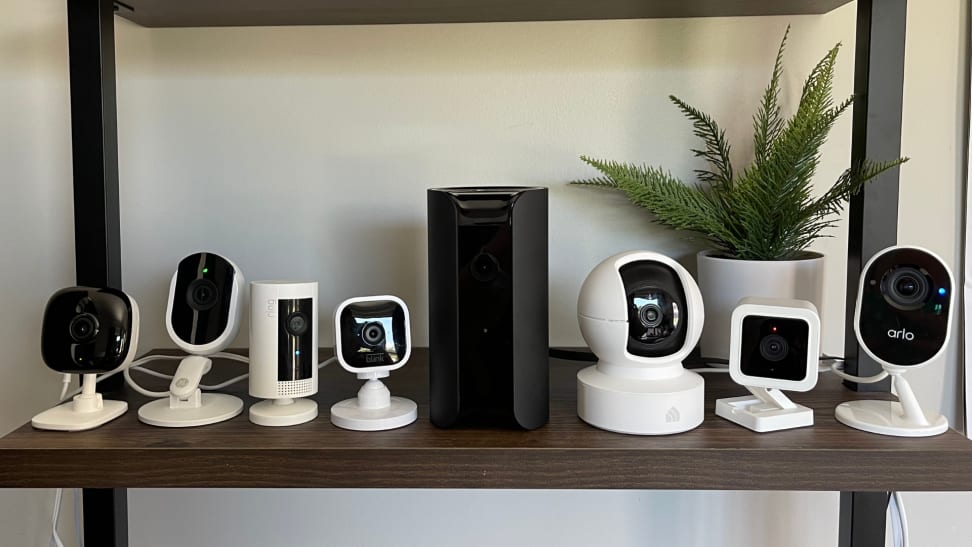
In the same way outdoor security cameras monitor the perimeter of your home, indoor security cameras offer a quick and easy way to keep an eye on things behind closed doors while you’re away. Smart indoor security cameras offer features like motion tracking, two-way talk, storage, and compatbility with smart assistants like Alexa and Google Assistant. To help you decide what to buy, we’ve put the top-rated smart indoor security cameras from Arlo, Wyze, Google Nest, and more to the test.
Smart indoor security cameras should be private, reliable, compact, and quick to send smart alerts like one of our top picks, the Arlo Essential Indoor Camera (available at Amazon for $59.99) . After weeks of testing, the Arlo proved its mettle with features like an integrated privacy shield that can be toggled on/off from the companion app.
But there are plenty of other great indoor security cameras in our guide that will make the perfect lookout for your home.
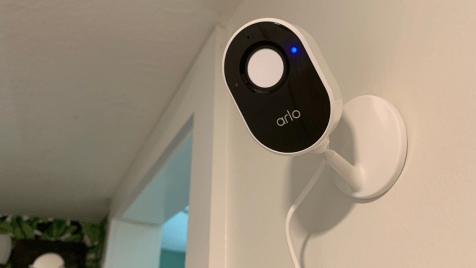
The integrated camera privacy cover is one of the most appealing features of Arlo’s Essential Indoor Security Camera.
BEST OVERALL
Arlo Essential Indoor Security Camera
Arlo’s Essential Indoor Security Camera impressed us from the start with its sliding privacy shutter that can be toggled on/off from the companion app. It records in crisp and clear 1080p HD video and offers a 130-degree field of view, allowing you to see everything in the room.
Arlo’s camera is also among the fastest and smartest when it comes to detecting and sending intelligent alerts. When paired with an Arlo Secure Plan, it can differentiate between people and animals (and packages and vehicles, though you don’t need those alerts for inside). The paid plan also gets you access to cloud video storage, so you can review and share video clips.
Arlo’s preview notifications are helpful, too, allowing you to watch a quick clip without opening the app. Even better, all detected objects are outlined in green so you can quickly identify what’s going on from the preview alert.
The camera offers four modes (armed, disarmed, schedule, and geofencing), all of which performed well during our testing, alongside excellent security features.
The Arlo app offers two-factor authentication, an important feature to keep your account secure. If a new login is detected, Arlo will alert you immediately with a push notification where you’ll need to confirm or deny the device trying to gain access to your account. There’s also a built-in siren and access to emergency services, should you ever need it.
If there’s one downside to this camera, it’s that it’s fairly lightweight and can easily be knocked over if you don’t opt to mount it with the included hardware. But its small footprint and discreet design make this camera easy to incorporate into any home without the constant feeling that you’re being watched.
The camera works with Amazon Echo and Google Home smart displays. It also works with Apple HomeKit, so long as you have an Arlo Smart Hub.
Overall, this is a discreet home security camera that’s well-priced, intelligent, and reliable for everyday home security.
Best Indoor Securıty Cameras 2023
Read More : Best DVR App For Android
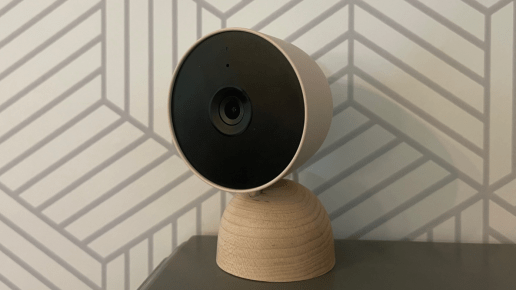
The Nest Cam (indoor, wired) has privacy features like two-step account verification and encryption for video recordings.
BEST FOR GOOGLE ASSISTANT
Nest Cam (indoor, wired)
The Nest Cam (wired, indoor) is priced fairly against the competition and does everything you’d expect it to. It records in the industry standard 1080p, comes with two-way talk, and quickly sends notifications when it detects motion. But it’s got something most others don’t: free intelligent alerts (people, animals, cars) and a three-hour event history right out of the box. More features are available with a paid subscription.
The camera comes with an integrated power cord that plugs into any standard electrical outlet. Unlike previous indoor Nest cameras, this model is offered in several different colors and a smaller, more attractive design. Another perk of this camera is that it records locally for up to one hour in the event your internet connection drops out.
There’s no support for Apple HomeKit, but it does work for viewing on Amazon Echo smart displays when you connect the Google Nest Skill for Alexa. You can also pull up the camera’s live view on a Google smart display like the Nest Hub Max or Nest Hub (second-gen).
Even if you don’t have an expansive Google Home setup, this camera is spot on and one of the best indoor home security cameras you can buy for the money.
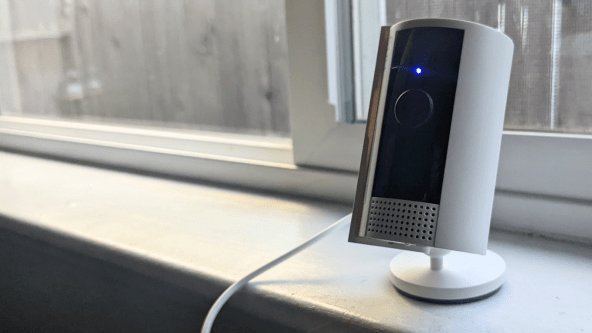
BEST FOR ALEXA
Ring Indoor Cam (2nd Gen)
The second-gen Ring Indoor Camera is the best camera for Alexa. The security camera is a notable improvement over the first generation, as it now includes a manual privacy cover to prohibit viewing, listening, and recording when enabled. Overall, the new Ring security camera delivers in other areas, too, like performance, features, and simplicity, making it one of the best you can buy.
The camera, which comes with a long 6.5-foot power cord, is easy to install sitting flat on a surface, like a shelf or using the included swivel mount. The compact size, which comes in white or black, is also ideal if you want a discreet home security camera.
Performance-wise, the Ring Indoor Cam features 1080p resolution, two-way audio, and a surprisingly wide field of view for such a small security device. With the added benefit of things like Customizable Motion Zones, motion notifications, and a siren that can act as the first line of defense when an intruder comes into view, the Ring Indoor Cam is well-equipped to protect your space. It also works seamlessly with other Amazon smart home devices, meaning you can pull up the live view on an Echo smart display.
This security camera is one of the few with a privacy shutter. We also like other privacy controls about this camera, like designating off-limits areas so it doesn’t capture motion or recordings. It also features end-to-end encryption and mandatory two-factor authentication via the Ring app.
On the downside, many features, like saving and sharing videos and person alerts, are only accessible with a paid Ring subscription plan. Other cameras, like the Nest Indoor camera, include these features at no charge. Outside of that, the second-generation Ring Indoor Cam is one of the best indoor security cameras for performance, features, and privacy—especially if Alexa is your preferred smart assistant.
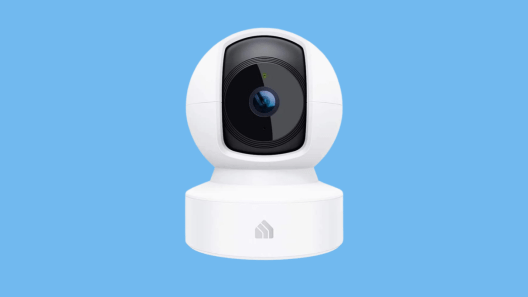
BEST 360-DEGREE CAMERA
TP-Link Kasa Spot Pan Tilt 410S
Want a 360-degree view of what’s going on at home? That’s exactly what you’ll get with the Kasa Spot Pan Tilt indoor security camera, which can be mounted to the ceiling or placed on a solid surface.
It offers impressive 2K video resolution and motion-tracking capabilities that offer a remarkably clear view during day and night. The remote pan/tilt function mostly works well, allowing you to pan the room to check in on your pets, kids, and dogs, or while you’re away on vacation.
Access to activity notifications, activity zones, two-way talk, and live streaming is free of charge. The Kasa Care plan includes 30 days of video history, manual recording, activity notifications with snapshots, and video sharing. Kasa claims your video feed is secured with industry-standard 128-bit AES encryption with SSL/TLS directly from the camera.
The camera also works with Amazon Echo and Google Home, so you can pull up the live stream on a compatible device like a smart display.
Overall, this camera is one of the fastest at detecting motion alerts we’ve tested and the audio is among some of the best, too. We like the video preview alerts, which make it easy to see what’s happening without opening the app, and the ability to pan and tilt the camera to get a better view of what’s happening inside.
Other Indoor Security Cameras We Tested

TP-Link Kasa Spot KC400
The Kasa Spot KC400 is one of the latest models from TP-Link Kasa. It’s one of the only models in our guide that records in 2K resolution instead of the standard 1080p. Though it doesn’t have color night vision, the black-and-white view is incredibly sharp in the dark and can detect motion up to 30 feet away.
Another major perk to this camera is that it is capable of nonstop video recording, so you can feel secure about your indoor space even when you’re away on a long vacation.
It supports local storage via a microSD card (up to 256 GB). Cloud storage is also available for up to 30 days via a Kasa Care Plan. The indoor Kasa Spot Cam is capable of recognizing people, motion, and sound (including a crying baby), and sending informative push alerts so that you don’t have to check in with the app for every notification. In the Kasa app, you can create activity zones. This can help prevent false alerts if there’s a particular area you want the camera to watch over.
It works well with Alexa and Google Assistant to pull up the live stream on a compatible smart display.
The Kasa app is quick at loading the camera’s live feed and the audio quality is excellent.
If you need a smart indoor camera loaded with features that offers some of the best video quality we’ve tested, you can’t go wrong with the Kasa Spot Cam.
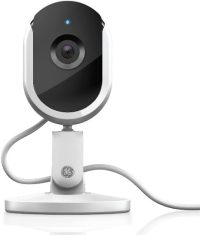
Cync Indoor Camera
The Cync Indoor Camera 1080p camera records clear video and there was no delay when we tested out the camera’s two-way talk capabilities. Like most smart security cameras, you can use Alexa or Google Assistant to stream the live feed to an Amazon Echo or Nest smart display, but you can’t communicate with the camera using either smart display (and it is not compatible with Apple HomeKit).
We like the built-in camera shutter for added privacy, but you can’t toggle the shield from the app—you have to physically move the shutter, which decreases the privacy value of the camera if you have it mounted in a hard-to-reach spot. However, the camera is quick to detect motion and alerts you immediately to events.
The camera comes with a 30-day free trial to Cam Cync, a paid subscription that gets you 14 days of unlimited clip storage. With the monthly plan, you can also filter clips by motion, sound, or people, and download clips to share with friends and family as well. Account security features like end-to-end encryption for cloud storage and two-factor authentication are available with the Cync app. Local storage is also available using the camera’s microSD card slot.
During our testing, the companion app ran slower on iOS than on Android, but once everything loaded it was easy to access all the camera has to offer. The slow app is a bit of a nuisance and we wish the shutter could be controlled remotely, but overall the camera performs well, offers features to keep your account secure, and integrates nicely with the Cync smart home ecosystem.
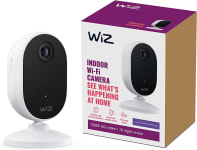
WiZ Indoor Security Camera
The WiZ Indoor Security Camera does a good job of watching over the interior of your home, sending timely alerts, and recording in clear, 1080p HD video.
It has a 120-degree field of vision and works with Alexa, Google Assistant, and Siri shortcuts. It comes with a USB power cable but no plug—a minor inconvenience, but one to be aware of. The camera can detect motion, people, and objects without a paid subscription plan and does not require a hub for use.
The camera connects in the WiZ V2 app. There are two WiZ smart home apps, so make sure you choose the right one. We found the app mostly easy to use, but it took us some getting used to.
This camera is unique because, with the right setup, it uses WiZ’s SpaceSense technology, which turns your WiZ smart bulbs into motion sensors. In turn, when motion is detected, the bulbs can be set up to turn on to help alert or deter whoever or whatever is there. The downside is that this technology only works with WiZ products. It does not have a built-in siren like our No. 1 pick.
During our testing, we found the motion detection to be accurate and the video quality looks good. It offers infrared night vision, which many indoor security cameras do not have. The two-way audio is loud and clear, too, allowing you to communicate remotely with anyone in the room—like pets and kids.
You can use voice assistants like Alexa and Google to control the camera for functions like turning it on and off.
Overall, this is a solid indoor security camera with good features and is best used in conjunction with other WiZ smart home devices.
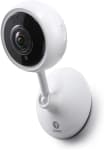
Swann Tracker Security Camera
The Swann Tracker includes plenty of features, but unfortunately also forces users to deal with some frustrating communication delays and issues with settings. Sometimes, the camera light refused to shut off when it was supposed to, and there was also some lag in terms of live viewing. During the initial setup, the camera failed to make a connection until multiple restarts were performed.
On the plus side, the Tracker boasts excellent 1080p video, a 180-degree field of view, and an abundance of local storage (a whopping 2TB) to keep all the hours of footage that you need.
It can’t be used for outdoor surveillance, but using it inside will net you automatic pan and zoom features as well as two-way audio, night vision with an infrared view, and automatic motion tracking.
The camera’s design is intriguing, resembling something like a lollipop. Its app is easy to use, but the Tracker suffers significant lag in its two-way communication. When you go into your app to change settings as well, sometimes your alterations aren’t saved, which can lead to some serious frustrations.
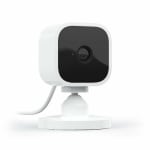
Blink Mini
If you need a simplistic indoor camera, the Alexa-only Blink Mini is a worthy contender. It doesn’t offer a continuous live stream or web viewing, but it reliably tracks motion and you can see all events in the Blink app. It lacks preview alerts, a convenient feature that allows you to quickly view the motion event without opening the companion app. It also doesn’t alert you to different types of motion events, like people or animals. The push notifications are sent as general motion alerts, so you have to open up the app for a better look at what’s going on.
On the upside, this camera is uber small and lightweight, making it easy to set up and install just about anywhere at home. You can pull up the camera’s live stream on an Echo Show display, but it doesn’t work with Google Home or Apple HomeKit. It’s got a 110-degree field of view, which is on the small side for a home security camera.
But it offers desirable app security features, like two-factor authentication and email alerts when a new login is made. A paid subscription plan is available, though a free trial is included with your purchase.
If you’re on a budget and need a cheap camera, the Blink Mini will suffice but don’t expect anything luxurious.

Canary Pro
The Canary Pro is a stout home security camera that has an impressive 147-degree field of view and records in standard 1080p HD video. Overall, the setup is fairly simple, though creating your account and enabling two-factor authentication cannot be done from the app and must be done from a web browser instead.
We were able to get the camera connected to Alexa and pull up a live stream on an Echo Show smart display, but we could not get it to integrate with Google Home. The 1080p video is clear both day and night, but we found the audio to be muffled and hard to understand.
A Canary Premium Subscription is required to access features like your 30-day video history (Canary offers end-to-end video encryption and encrypted cloud storage), two-way talk, and intelligent alerts like person detection. It’s one of the more expensive plans in our guide, but to help ease the cost, a free, one-year trial is included with your purchase, adding some extra value.
In addition to video, the camera can also keep tabs on the air quality inside of your home, sending alerts when the air quality is bad or the humidity is too high.
There’s also a built-in siren and access to emergency services, giving this camera more of a DIY home security system feel than most indoor cameras.
If you need extra features like humidity and air quality monitoring, plus the capability to check in and see what’s going on at home, the Canary Pro is worth a look.

Canary Pro
The Canary Pro is a stout home security camera that has an impressive 147-degree field of view and records in standard 1080p HD video. Overall, the setup is fairly simple, though creating your account and enabling two-factor authentication cannot be done from the app and must be done from a web browser instead.
We were able to get the camera connected to Alexa and pull up a live stream on an Echo Show smart display, but we could not get it to integrate with Google Home. The 1080p video is clear both day and night, but we found the audio to be muffled and hard to understand.
A Canary Premium Subscription is required to access features like your 30-day video history (Canary offers end-to-end video encryption and encrypted cloud storage), two-way talk, and intelligent alerts like person detection. It’s one of the more expensive plans in our guide, but to help ease the cost, a free, one-year trial is included with your purchase, adding some extra value.
In addition to video, the camera can also keep tabs on the air quality inside of your home, sending alerts when the air quality is bad or the humidity is too high.
There’s also a built-in siren and access to emergency services, giving this camera more of a DIY home security system feel than most indoor cameras.
If you need extra features like humidity and air quality monitoring, plus the capability to check in and see what’s going on at home, the Canary Pro is worth a look.
How We Test Smart Indoor Security Cameras
The Tester
Hi, I’m Rachel. I live in a home full of voice-activated smart speakers, remote-controlled light switches, and a slew of other connected gadgets. I’m the senior staff writer for Reviewed’s smart home section, helping to test everything from smart coffee makers and pool water monitors to the latest video doorbells and home security systems.
The Tests
I installed each camera in my 1,400-square-foot house, replacing my usual motion-detecting 24-hour camera, and tested each one for a set period. I also tested the cameras side-by-side to find out which responds the fastest in real time. Testing procedures included noting each camera’s ease of installation, mobile app setup, ease of use, reliability, and compatibility with smart assistants Alexa and Google Assistant.
Testing also included a lengthy period of regular use in my home as I evaluated video and audio quality, responsiveness, uptime, and app usability. Additionally, each camera and companion app has been evaluated for privacy and security features to help keep your smart home secure. I installed each camera’s mobile app on an iPhone 12 Pro Max and a Samsung Galaxy Tab A to ensure the app experience was the same across each platform.
What You Should Know About Smart Indoor Security Cameras
Privacy
Even your security camera needs security. So, what should you look for? Features like two-factor authentication, end-to-end encryption, and the option for local video storage are all things to consider before investing in a smart security camera setup.
Two-factor authentication, which sends a code to your mobile device to verify it’s you, is available on many home security cameras and is something to seek out and activate. That way, if someone tries to hack into your account, you will receive an alert and can quickly take care of the problem.
Another thing to consider is how your videos are used and stored. Most home security cameras allow you to turn them on and off from the app to control when they’re recording and uploading video to the cloud. Look for end-to-end encryption for storing videos. The encryption offers a layer of protection that can help prevent unwanted eyeballs from viewing your saved and stored videos.
Make sure you create a strong password that’s unique to your camera’s app. Data breaches feel like the norm as of late, making it all the more important not to reuse passwords across multiple websites and apps.
Finally, when using these devices with smart assistants like Alexa, Google, and Siri, you can help protect your privacy by regularly deleting your voice recordings and muting the speaker’s mic when it’s not in use.
Looking for more privacy tips? Read our guide to securing your smart home.
How to Setup an Indoor Security Camera
Setting up most indoor cameras is a fairly simple process. Download the companion app, plug in the camera, and follow the in-app instructions. Most security cameras require a 2.4GHz internet connection, as do most smart home devices, so make sure your connection is compatible. If you have a dual-band network, you may need to pause the 5G temporarily to connect your camera to your wireless network.
Most home security cameras generate a QR code in the companion app during setup to pair the camera with your account. Simply hold your phone or tablet about six to eight inches from the camera, with the QR code displayed, and the camera will begin the pairing process. Once set up in the app, you can link the camera with compatible voice assistants for hands-free control.
Many cameras in our guide require an electrical outlet for power and come with all the included plugs and cables you need to get it up and running. Cameras can be mounted to the wall or ceiling using the included hardware, or placed on a flat surface like a bookshelf or desk. If you’re using a motion-tracking camera, make sure to place it in an area that’s free of obstruction so you can always see what’s going on. If you don’t want to be tied to an electrical outlet, look for a camera that is battery-powered.
Finally, you should never install an indoor camera outdoors (unless it’s also rated for outdoor use). Outdoor cameras are designed to handle different temperatures and heavy rain/strong wind that indoor cameras can’t.
What To Look For In An Indoor Security Camera
Picture quality is arguably one of the most important features to look for in a security camera. A video recording resolution of 1080p is standard on most indoor security cameras, though some offer higher resolutions. Other cameras may toggle down to 720p to reduce bandwidth when necessary, so make sure to check the specs before you buy. Another feature to look for is the viewing angle. A good indoor security camera typically has a field of view in the 130-degree to 140-degree range for whole-room coverage. The larger the view, the more you will see.
Another important feature is two-way talk, which is readily available on most smart cameras. This means you can speak from the companion app to the camera and vice versa.
The live feed for indoor cameras can be accessed via the companion app, most of which are compatible with both iOS and Android devices. Some cameras may offer web viewing, too, but many don’t.
Most cameras will store your footage in the cloud for a monthly fee, though some offer free cloud storage for a certain amount of time. That means it’s stored on a remote server instead of a memory card. Not only does cloud storage claim to safely back up your footage, but you can also access your clips anywhere.
A paid subscription is common for most cameras and ranges anywhere from a few bucks a month to roughly $10. In addition to cloud storage, such plans usually include access to a variety of features like intelligent detection alerts, the ability to share clips with others, and more. It’s an additional cost on top of the camera, and plans vary by brand, but the price is often worth paying for thanks to all of the useful extras.